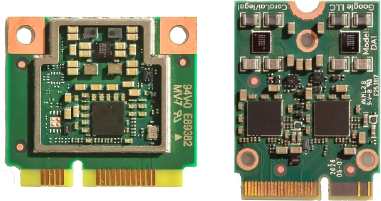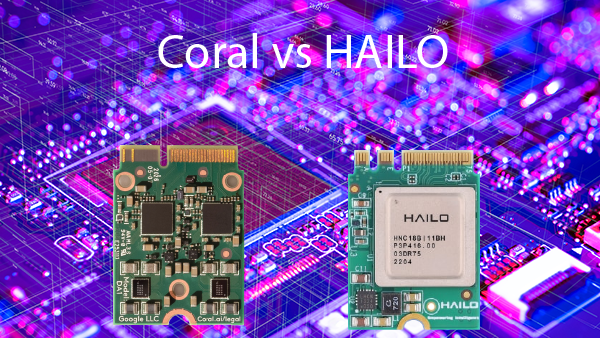If you’re diving into the world of AI and edge computing, you know that the right hardware can make or break your project. Today, we’re pitting two of the heavyweights in this space against each other: Coral TPU by Google and the HAILO AI processor by Hailo Technologies
Architecture: The Brains Behind the Brawn

Coral TPU Processors – Image Courtesy of Coral
Coral TPU: Google’s Coral TPU is like a finely-tuned sports car built for edge AI tasks. It leverages the Edge TPU, a custom ASIC crafted to execute AI inference at the edge with blazing speed.
Optimized for TensorFlow Lite, the Coral TPU lineup includes everything from dev boards to USB and PCIe accelerators, offering flexibility for various deployment scenarios. It’s all about delivering peak performance with minimal power draw.

Hailo AI Accelerators – Image Courtesy of HAILO
HAILO: Now, meet the Hailo-8, the powerhouse from Hailo Technologies, an Israeli startup that provides AI accelerator chipsets.
Designed from scratch for deep learning, this processor is all about efficiency and speed. Its dataflow-based architecture ensures that data streams are processed with lightning-fast latency and minimal power consumption.
Available in M.2 and Mini PCIe formats, the Hailo-8 is ready to tackle a wide array of edge AI challenges.
You’ll notice that M.2 is a standard form factor for these boards since it makes them compatible with many boards, allowing you to add AI acceleration to any system.
Performance: AI Speed Demons on the Edge
- Let’s get to the important part about these accelerators. After all, the point of adding accelerators is to speed up processing. With a generic processor you may be able to process some images, but it will run slowly. Adding the accelerator lets you process images at higher speeds so you get usable frames per second and handle more objects.
Coral TPU Performance: When it comes to raw performance, the Coral TPU doesn’t disappoint. The single chip version provides up to 4 TOPS (Tera Operations Per Second), or 8TOPS for the dual version. It excels at running AI inference tasks swiftly. It’s particularly adept at handling quantized neural networks, which are a must for power-sensitive edge applications. Think of it as the ideal companion for your real-time, on-device AI needs.
HAILO : If the Coral TPU is a sports car, the Hailo-8 is a high-performance race car. Boasting up to 26 TOPS for the standard variant, and 13 TOPS for the Hailo-8L Entry-Level, it’s built for real-time processing and can juggle multiple AI models without breaking a sweat. This makes it perfect for complex tasks like autonomous driving, industrial IoT, and smart city infrastructure.
The Hailo-8 is all about delivering top-tier performance where it matters most.
Power Efficiency: Mighty Yet Efficient
Coral TPU: Power efficiency is Coral TPU’s middle name. Designed for high performance per watt, it’s perfect for battery-operated devices and thermally constrained environments. Typically consuming around 2W to 4W, the Coral TPU ensures your edge devices stay cool and operational for longer.
HAILO: Don’t let the Hailo-8’s performance stats fool you into thinking it’s a power hog. It’s engineered for efficiency, typically drawing between 2.5W to 5W. Thanks to its dataflow architecture, it only performs the necessary computations, slashing unnecessary power use and maximizing efficiency.
Use Cases: Finding the Right Fit
Coral TPU: The Coral TPU is a versatile workhorse, ideal for:
- IoT Devices: Perfect for low-power IoT applications needing local AI processing.
- Smart Cameras: Real-time image and video processing is a breeze.
- Robotics: Great for advanced robotics requiring on-device AI inference.
HAILO: The Hailo-8 shines in more demanding environments, including:
- Autonomous Vehicles: High performance and low latency are essential for real-time decision-making.
- Industrial Automation: Efficiently handles complex AI models for industrial IoT and automation.
- Smart Cities: Supports multiple AI models simultaneously, ideal for managing smart city infrastructure.
The Verdict: Choosing Your Champion
In the Coral TPU vs. HAILO showdown, both contenders bring unique strengths to the table.
The Coral TPU is your go-to for high performance per watt, user-friendly TensorFlow Lite integration, and versatility in form factors. On the flip side, the Hailo-8 is the beast you need for high-performance, low-latency applications that demand significant computational muscle and the capability to run complex models concurrently.
Ultimately, your choice hinges on your specific application needs. Do you prioritize power efficiency and ease of use? Go for the Coral TPU. Need raw power and the ability to handle intricate AI tasks? The Hailo-8 is your best bet.
Both processors are at the cutting edge of edge AI computing, pushing the boundaries of what’s possible.
So, who will you choose in this ultimate AI showdown? Let me know in the comments below!

